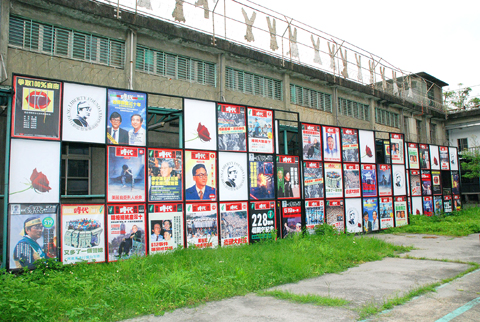Preserving infamous former prisons and turning them into museums may help to teach future generations important human rights lessons, speakers at a panel on prison museums said yesterday.
The panel — part of the Green Island Human Rights Arts Festival — was held yesterday by the Council for Cultural Affairs (CCA) at the Taiwan Human Rights Memorial in Jingmei (景美), Taipei.
The Jingmei human rights memorial park is home to the courtrooms where political prisoners were tried during the 1960s to the 1980s period of the Martial Law era, and the facilities where they were imprisoned.

PHOTO: CNA
Political prisoners from the former Jingmei martial law prison stayed in very small cells with toilets located inside the cells.
They were often tortured, abused and forced to work as cheap labor, former political prisoners said in a video shown prior to the beginning of the panel.
“It’s important to preserve these buildings so that people can be reminded of what once happened here — if we don’t know our history, it may repeat itself,” CCA vice-chairman Wu Chin-fa (吳錦發) told the audience.
“If we’re unaware of it, human rights abuses could continue to happen in any corner of society — maybe in different forms — even in a democracy,” he said.
Guest speaker, Rich Weideman, public affairs chief for the Golden Gate National Recreation Area in California, agreed that former prisons have important educational value.
He has worked as a tour guide at Alcatraz Island prison since 1980 and participated in the design of education curriculums about the prison.
Alcatraz was first used as a military base to protect San Francisco from attacks in the 1850s. It was turned into a military prison in 1909, and then a federal prison in 1934.
The prison was closed in 1963, and it was officially inaugurated as a tourist attraction in 1972.
“People have many misconceptions about prisons, because Hollywood movies and the media glamorized life in Alcatraz,” he said. “Therefore I think a tour of the prison presents a very good educational opportunity.”
To show what life on Alcatraz was really like, visitors follow in the steps of prisoners from the moment they arrived on the island. The tours are accompanied by voice recordings of former prisoners, guards and their families, telling their stories, Weideman said.
“It’s very important [for tourists] to get into the mindset of these prisoners — and some actually leave the place in tears,” he said.
“If what we do keeps even one kid out of prison, it’s worth the effort,” he said.
Park Goo-yong, a philosophy professor at South Korea’s Chonnam National University, and one of the planners of the May 18 Liberty Park in Gwanju, South Korea, shared similar views.
The May 18 incident happened in 1980 when tens of thousands of South Koreas demonstrated against military dictator Chun Doo-hwan — who had just taken control of the government following a coup — but were faced with a violent crackdown.
In order to commemorate the event, the May 18 Liberty Park was created in 1998 to preserve the martial-law courtroom and the military prisons.
“For many Koreans, the May 18 incident belongs to the past, and people only think about it every May,” Park said. “With the park and preservation of the historic space, we intend to educate our children about the history, so that they can learn about the core values of the uprising.”

A strong continental cold air mass is to bring pollutants to Taiwan from tomorrow, the Ministry of Environment said today, as it issued an “orange” air quality alert for most of the country. All of Taiwan except for Hualien and Taitung counties is to be under an “orange” air quality alert tomorrow, indicating air quality that is unhealthy for sensitive groups. In China, areas from Shandong to Shanghai have been enveloped in haze since Saturday, the ministry said in a news release. Yesterday, hourly concentrations of PM2.5 in these areas ranged from 65 to 160 micrograms per cubic meter (mg/m³), and pollutants were

Taiwan’s armed forces have established response protocols for a wide range of sudden contingencies, including the “Wan Chun Plan” to protect the head of state, the Ministry of Defense (MND) said today. After US President Donald Trump on Saturday launched a series of airstrikes in Venezuela and kidnapped Venezuelan President Nicolas Maduro, concerns have been raised as to whether China would launch a similar “decapitation strike” on Taiwan. The armed forces regularly coordinate with relevant agencies and practice drills to ensure preparedness for a wide range of scenarios, Vice Minister of National Defense Hsu Szu-chien (徐斯儉) told reporters before a

EVA Airways on Saturday said that it had suspended a pilot and opened an investigation after he allegedly lost his temper and punched the first officer several times as their plane was taxiing before takeoff at Los Angeles International Airport. According to a report published on Thursday by The Reporter, the incident occurred after the flight’s Malaysian first officer tried to warn the Taiwanese pilot, surnamed Wen (文), that he was taxiing faster than the speed limit of 30 knots (55.6kph). After alerting the pilot several times without response, the first officer manually applied the brakes in accordance with standard operating

NOT AN OPENING: Trump’s violation of international law does not affect China’s consideration in attacking Taiwan; Beijing lacks capability, not precedent, an official said Taiwanese officials see the US’ capture of the president of Venezuela as a powerful deterrent to Beijing’s aggression and a timely reminder of the US’ ability to defeat militaries equipped with Chinese-made weapons. The strikes that toppled Venezuelan President Nicolas Maduro signaled to authoritarian leaders, including Chinese President Xi Jinping (習近平), US President Donald Trump’s willingness to use military might for international affairs core to US interests, one senior official in Taipei’s security circle said. That reassured Taiwan, the person said. Taipei has also dismissed the idea that Trump’s apparent violation of international law could embolden Beijing, said the official, who was not